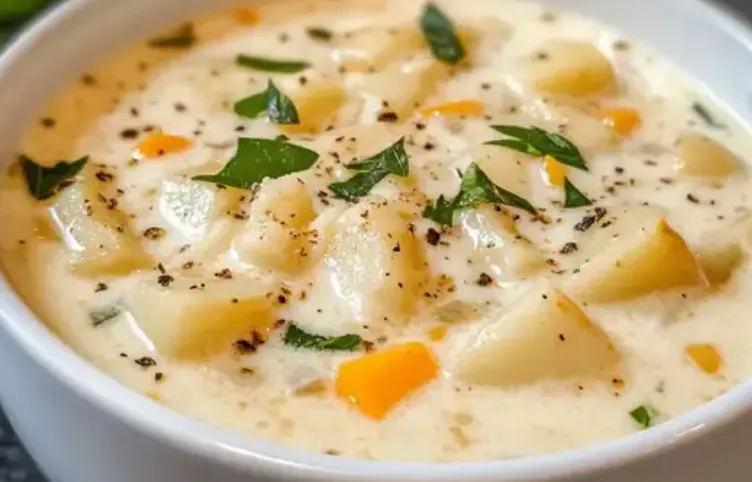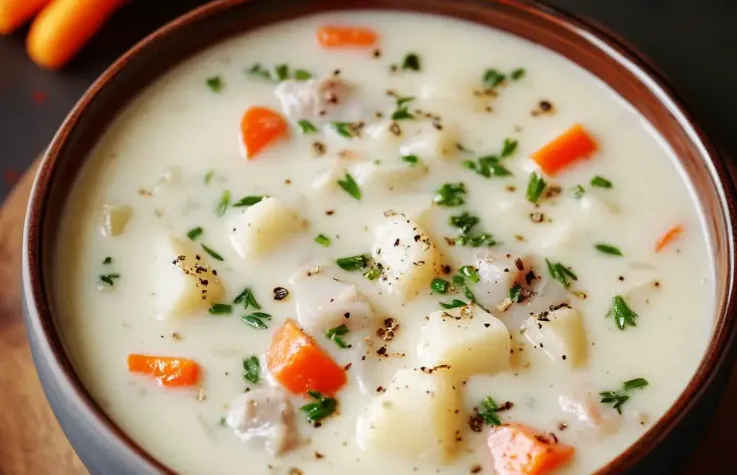Creamy Potato Soup
When it comes to soul-soothing dishes, few rival the indulgent allure of Creamy Potato Soup. Silky, savory, and effortlessly satisfying, it wraps you in warmth—ideal for blustery nights, intimate dinners, or solo cozy evenings.
Potatoes, long adored across continents for their adaptability and value, morph into something utterly decadent when crafted into this velvety soup. A true elixir of comfort and simplicity.
In this culinary walkthrough, discover how to build the ultimate bowl—from choosing the perfect spuds to finessing the flavor with the right blend of ingredients. You’ll find a step-by-step recipe, texture-enhancing tips, and flexible variations to meet every taste and lifestyle.

The History of Potato Soup
Potato soup has deep, earthy roots, stretching across cultures and centuries. While many civilizations have leaned on the potato as a staple, it was in Europe where creamy renditions of this soup began to bloom.
In Ireland, humble ingredients like potatoes, onions, butter, and milk came together in rustic harmony, resulting in a dish passed down for generations. France contributed its own elegant variation—potage Parmentier—named for Antoine-Augustin Parmentier, who brought the potato to prominence. Here, leeks and potatoes simmer into silken bliss.
As time moved on, new additions enriched the soup’s legacy—think bacon, cheddar, sour cream, and even the occasional crab or shrimp. Today, Creamy Potato Soup enjoys international fame, treasured for its nurturing essence and depth of flavor.
What Makes the Best Creamy Potato Soup?
Exceptional potato soup hinges on a trifecta—balance, texture, and layering of flavors. It’s more than a mere medley of starch and stock; it’s culinary comfort executed with precision.
1. Choosing the Right Potatoes
Different potatoes yield different results. For a lush texture:
- Russet Potatoes – High in starch, they break down easily, creating a naturally thick base.
- Yukon Golds – Creamy and buttery, these golden gems offer a smooth, rich mouthfeel.
- Red Potatoes – Less starchy, they retain structure and add bite for those who prefer a bit of texture.
Blending Russets with Yukons offers the best of both worlds—creamy yet complex.
2. The Importance of Aromatics
Flavor starts at the base. Key aromatics set the tone:
- Onions – Add a sweet, caramelized undertone.
- Garlic – Offers a nutty, mellow depth.
- Leeks – Subtle and refined, perfect for a French-inspired finish.
- Celery and Carrots – Optional, but excellent for deepening the profile.
3. The Perfect Broth
Broth provides structure and richness:
- Chicken Broth – Adds savory, umami-forward notes.
- Vegetable Broth – Ideal for a plant-based approach.
- Homemade Stock – The gold standard—if you have the time, it’s worth every simmered second.
4. How to Achieve the Creamiest Texture
Texture is everything. Here’s how to master the mouthfeel:
- Blending – Use an immersion blender for smooth consistency; a high-speed blender delivers a silky finish.
- Mashing – For a rustic feel, hand-mash a portion of the soup.
- Dairy Additions – Whole milk, heavy cream, sour cream, or cream cheese bring it all together in indulgent harmony.
5. Enhancing Flavor with Seasonings
Seasoning elevates the humble potato into something spectacular:
- Salt & Black Pepper – Foundational and necessary.
- Thyme & Rosemary – Add earthy, woodsy warmth.
- Smoked Paprika – Introduces a whisper of smokiness.
- Cheese – Aged cheddar, sharp Parmesan, or creamy Gouda offer depth and boldness.

How to Make Creamy Potato Soup (Step-by-Step Recipe)
Ingredients
For the Soup:
- 4 large Russet or Yukon Gold potatoes, peeled and diced
- 1 medium onion, finely chopped
- 2 cloves garlic, minced
- 3 tbsp butter
- 3 tbsp flour
- 4 cups chicken or vegetable broth
- 1 cup heavy cream or whole milk
- 1/2 cup sour cream (optional)
- 1 tsp salt (adjust to taste)
- 1/2 tsp black pepper
- 1/2 tsp thyme (fresh or dried)
- 1/4 tsp smoked paprika
For the Toppings:
- 1/2 cup shredded sharp cheddar
- 1/4 cup crumbled crispy bacon
- 2 tbsp chopped chives or green onions
- Extra sour cream for garnish
Instructions
Step 1: Sauté the Aromatics
Melt butter in a large pot over medium heat. Add onion and cook until soft and translucent—about 5 minutes. Stir in garlic and sauté briefly until aromatic.
Step 2: Make the Roux
Sprinkle in the flour and stir for 1–2 minutes to cook off the raw flavor. This forms the thickening foundation.
Step 3: Add the Potatoes and Broth
Gradually whisk in the broth, smoothing out any lumps. Add diced potatoes, salt, pepper, thyme, and smoked paprika. Bring to a gentle simmer and cook for 20 minutes, or until potatoes are tender.
Step 4: Blend or Mash the Soup
Use an immersion blender for a smooth result or a stand blender in careful batches. Prefer a bit of texture? A hand masher will do.
Step 5: Add Dairy for Creaminess
Lower the heat and stir in cream and sour cream. Simmer gently for 5 minutes to marry the flavors.
Step 6: Serve with Toppings
Ladle into bowls, top with cheese, bacon, chives, and a touch of sour cream for garnish.

Variations and Customizations of Creamy Potato Soup
1. Vegetarian & Vegan Option
Swap in vegetable broth. Use coconut milk or cashew cream in place of dairy. Skip bacon or use plant-based versions.
2. Loaded Baked Potato Soup
Crumble in cooked bacon, more cheddar, and even a dollop of sour cream for a hearty twist.
3. Spicy Potato Soup
Add a dash of cayenne or your favorite hot sauce for some bold heat.
4. Cheesy Potato Soup
Up the ante with extra cheese—cheddar, Parmesan, or a smoked Gouda for depth.

Frequently Asked Questions
What are the best potatoes to use for creamy potato soup?
Russet and Yukon Gold potatoes are ideal. Russets create a naturally thick texture due to their high starch content, while Yukon Golds offer a creamy, buttery finish. For a balanced result, use a mix of both.
Can I make creamy potato soup without cream?
Yes. You can substitute cream with whole milk, half-and-half, or dairy-free alternatives like coconut milk or cashew cream for a lighter or vegan-friendly version.
How do I make my potato soup thicker?
Use a roux (butter and flour mixture) as a thickening base, and blend some or all of the cooked potatoes. You can also let the soup simmer uncovered to reduce and thicken naturally.
Is it better to blend or mash the soup?
It depends on the desired texture. Blending gives a silky-smooth finish, while mashing leaves small chunks for a rustic feel. You can combine both techniques for a balanced texture.
Can I make this soup ahead of time?
Absolutely. Potato soup stores well in the refrigerator for up to 3–4 days. Reheat gently over low heat and stir well to restore creaminess.
Can I freeze creamy potato soup?
Yes, but with caution. Dairy can separate when frozen. To avoid texture issues, freeze before adding cream and stir it in after reheating.
How can I add protein to potato soup?
Try stirring in cooked bacon, shredded chicken, diced ham, or even white beans for added protein and heartiness.
What toppings go well with creamy potato soup?
Popular options include shredded cheddar, crispy bacon, sour cream, green onions, chives, and a dash of hot sauce or smoked paprika.
Can I make this soup vegetarian or vegan?
Yes. Use vegetable broth instead of chicken broth, plant-based milk or cream substitutes, and omit meat-based toppings. Vegan cheese and bacon alternatives work well too.
Why does my potato soup taste bland?
Potatoes are naturally mild and require proper seasoning. Add salt gradually, incorporate aromatics like garlic and onion, and consider herbs such as thyme, rosemary, or a pinch of smoked paprika for extra depth.
Conclusion
Creamy Potato Soup is the edible equivalent of a warm hug. Whether ladled into mugs on winter nights or dressed up for a dinner party, it’s a dish that comforts and delights.
With its straightforward ingredients and approachable method, this timeless recipe proves that comfort food doesn’t require complication—just care. Grab your ladle, gather your garnishes, and serve up a bowl of pure culinary nostalgia.






